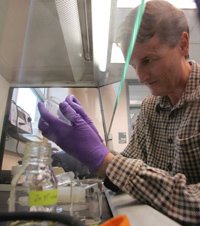 Colorado engineer John Spear stood on the edge of a 350-foot-wide sinkhole in a Mexican jungle in September and peered down into what may be the deepest cave in the world.
Colorado engineer John Spear stood on the edge of a 350-foot-wide sinkhole in a Mexican jungle in September and peered down into what may be the deepest cave in the world."I thought, 'This is a place where you don't want to drop your tools,"' Spear said.
Yet that's exactly what the Colorado School of Mines assistant professor intends to do.
Sometime in 2007, Spear and his colleagues hope to drop a 2,500- pound orange, M&M-shaped probe into the watery abyss to test a technique that someday may be used to search for life on Europa, one of Jupiter's moons.
That moon, wrapped in miles of thick, icy crust, is considered one of the best places beyond Earth to look for evidence of life, says University of Colorado planetary scientist Bob Pappalardo.
"It's because there's probably lots of liquid water beneath the ice and there may be the chemical energy that's needed to permit life," he said.
A mission to Europa, however, is so technically challenging, it's probably decades away, he said.
Spear agrees. "Those who plan today, it might be our academic grandchildren who play it out," he said. "We're just going to see what we can do with this machine and take it from there."
Spear and his colleagues are midway through a three-year, $5 million NASA grant to build a prototype robotic explorer.
Spear's role is designing ways to detectchanges in the temperature or chemical composition of water that might be associated with a hydrothermal vent or some other energy-related feature.
That's where organisms might gather, he said.
To search below Europa's ice, any robot would also need to know how to map and navigate a watery environment, and how to decide by itself where to pluck samples for testing.
That's where the cave, near Tampico, Mexico, comes in.
No one knows how deep it is, Spear said. It hasn't been mapped. (...)
Full article: denverpost.com
No comments:
Post a Comment